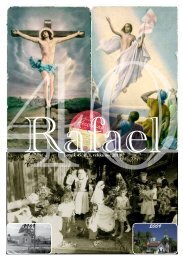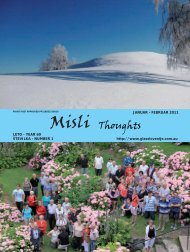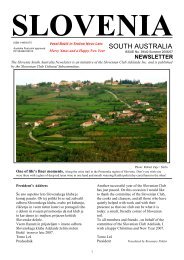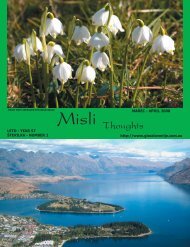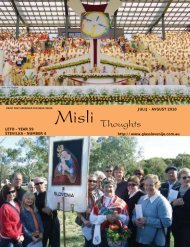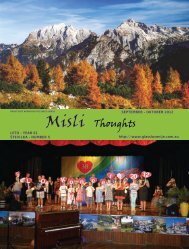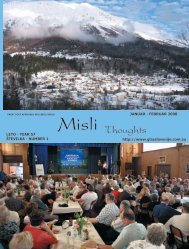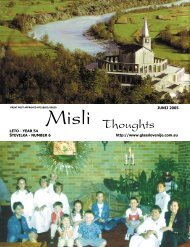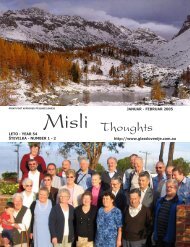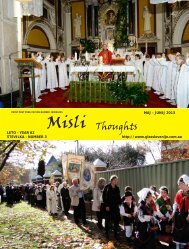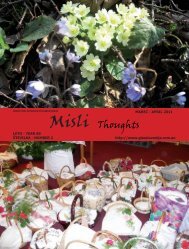The voice- - Glas Slovenije
The voice- - Glas Slovenije
The voice- - Glas Slovenije
Create successful ePaper yourself
Turn your PDF publications into a flip-book with our unique Google optimized e-Paper software.
2February March 2003Vladimir Bartol, the author of one the most widely translatedSlovenian novel, Alamut, would celebrate his 100th birthday onFebruary 24. When it was first published in 1938, Alamut wasreceived with considerable scepticism by critics. Now, decades later,critics and readers alike talk about it with nothing but superlatives.Bartol was born in 1903 in a small villagenear Trieste into the family of a postoffice worker, Gregor Bartol. His motherMarica was a teacher, writer and the editorof the first Slovenian women’s magazineSlovenka. While his mother laterlargely renounced her feminist views inpractice, the young Vladimir was adamantto pursue his dreams and become a writer.Not just any writer, but a world famousman of letters. <strong>The</strong> undeterred self-confidencethat he showed as a youngster later helped him weather thestorm of criticism that he was exposed to due to his life philosophyand writing. <strong>The</strong> family decided to move to Ljubljana whenVladimir was in secondary school. After finishing school in 1921,he went on to study biology and philosophy, and graduated with athesis entitled On Factors that Enable Living Organisms to ReactReasonably to External Impulses.<strong>The</strong> Formative YearsWhile at university, Bartol made friends with the youngphilosopher and alpine climber Klement Jug. Jug was a ferventbeliever in Nietzsche’s “will to power” and, unlike many otherphilosophers, he actually practiced what he preached. He undeniablyaffirmed his philosophy of an uncompromising rise of willpowerwhen he died climbing the excruciating northern face ofMount Triglav, Slovenia’s highest mountain, in 1924. Jug left anindelible impression on Bartol, the ultimate result being that hisopponents too often criticised him as a philosopher and ideologist,and forgot about his literary work.In the concept of “will to power”, Bartol found what heperceived as being the elementary characteristic that a small andthreatened national group like Slovenians need in their struggle topersevere. He was sharply critical as he discovered in Sloveniansthe characteristics of a weakened nation, brought up in humilityand fear of living. It was a nation defined by the cult of goodness—a goodness unfortunately, of the feeble.In a short story entitled “At the Crossroads” (1935), whereone of the characters can easily be recognised as modelled onKlement Jug, Bartol says: “Bunglers achieve nothing. Our nationhas always been a nation of bunglers and a friend of compromise”.Although this was a veiled call for a rise to arms in a nationalliberation struggle, the established intellectual elite started treatingBartol with considerable criticism; even more so after he publishedAlamut three years later. Bartol initially wanted to dedicateAlamut to an “unknown dictator”, but the editors nipped his intentionin the bud.AlamutSet in Persia in the 11th century, Alamut is the story ofHassan Ibn Sabah, an old man who becomes the head of theAshashini sect. Ensconced within his mountain citadel of Alamut,the “Caligula of the East” wages a horrifying holy war against theTurks who threaten to impose Sunnitism on the Persian Muslims.At first, Hassan Ibn Sabah seems week and undermanned comparedto the superior enemy. Yet he achieves a breakthrough witha small but utterly committed group of fedayee. <strong>The</strong>y are fanaticdesperados fearless of death. He gets them high on hashish, givesthem a taste of what they believe to be heaven, and sends them tosuicide missions they are eager to fulfil.Vladimir Bartol: Far Ahead of His Time<strong>The</strong> character of Hassan IbnSabah was strongly reminiscent of thelikes of Hitler, Mussolini and Stalin, whowere in power when the novel was published.It could thus be interpreted as awarning, but Slovenian critics were utterlyperplexed by the book’s “nothingis real, everything is allowed” doctrine,and Hassan Ibn Sabah’s “alienation ofthe people” method. “<strong>The</strong> lower the conscienceof the group, the greater its zeal,”Hassan would say. People who want tofight by his side must be in love withdeath.All of Bartol’s theses, as laid outin Alamut, seemed far out of the temporal and mental context of thetime, at least for the critics. This can hardly be said of 1988 and 1989though, when the novel was translated into French and Spanish. Alamutwas an immediate hit in France, and the 30,000 copies printed weresold out in a matter of months. It was even more successful in Spain:the first 10,000 copies sold out even before the book was officiallypublished. Alamut has since been translated into 15 languages, includingArabic. It also achieved its deserved recognition in Slovenia,as it became assigned reading in secondary school.In the Spotlight after 9/11<strong>The</strong>re are at least two reasons why the novel is now immenselypopular in Slovenia and abroad: the rise of Islamic terrorism,which took on a previously unseen form on September 11, 2001,and (what is often forgotten) the simple fact that the novel is a pageturner.<strong>The</strong> editor of the French edition, Jean Pierre Sicre, explainedhis decision to publish Alamut with the words “<strong>The</strong>re is a single principle:pleasure! <strong>The</strong>re are no others. A pure pleasure of reading”. Asis true of all great novels, Alamut is multi-layered. It can be read as ahistorical, philosophical, political or trivial text, or ultimately, as ametaphor that seems less and less abstract after the political turmoilof the recent years.After the initial negative attitude towards Bartol, Slovenianreaders have become increasingly approving of his work. Hopefullythis is not because Alamut has been confirmed as a masterpiece byothers, who are bigger than us. This would only indicate that not muchhas changed since Bartol complained about the humility and low selfesteemof Slovenians.More than Just AlamutAfter publishing the fourth reprint of Alamut in 2002 (thebook has been on the best-selling list for months) the publishing houseZaložba sanje also reprinted a collection of Bartol’s short stories, entitledAl Araf, in December. <strong>The</strong> title, which in Arabic means the wallbetween heaven and hell (the wall of cognition), is a bit misleading asthe 27 short stories are a psychological and philosophical view ofday-to-day problems of urban life. <strong>The</strong> short stories bear distinct fingerprintsof psychoanalysis, which was unusual of Slovenian literaryworks at the time. <strong>The</strong> only other contemporary of Bartol to applypsychoanalysis in his writings was Slavko Grum; he too only achievedcritical acclaim after his death. Založba sanje has already announcedit will shortly publish a selection of Bartol’s lampoons.Although disappointed at the less than rave reviews of hiswork, Bartol never lost his faith in his literary genius. He believedstrongly in Alamut, and recalled on an occasion: “I had had the feelingas if I was also writing for a readership that would live fifty yearsfrom now”. When he wrote the final word of his masterpiece, he becameparanoid about the possibility of someone stealing his manuscriptor losing it to a blaze of fire. “Let them kill me; I will be immortalin Alamut,” he wrote. Vladimir Bartol died a non-violent death in1967. It seems that he has become immortal, and that his writings arewalking Al Araf, the wall of cognition.



